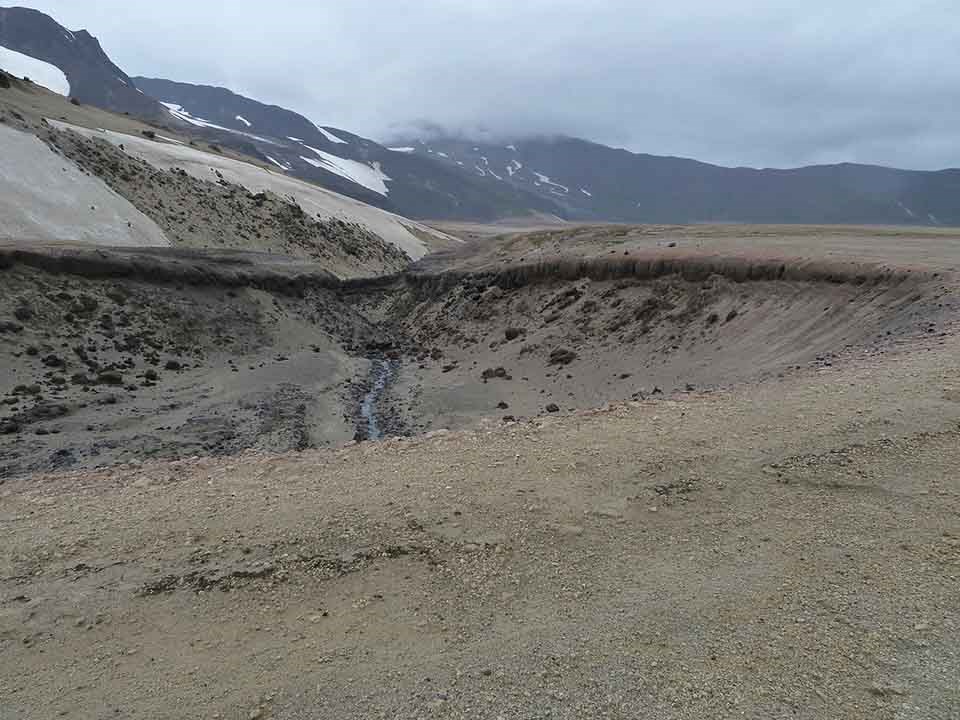
NPS/M Fitz
The shifting of tectonic plates is the cause of Alaska’s volcanoes. As the dense oceanic Pacific Plate advances, it is slowly sliding beneath the less-dense North American plate in a process called subduction. When the Pacific Plate reaches a depth of approximately 100 km below the surface, the increased heat and pressure cause the oceanic crust to release water, which reacts with the surrounding rock to create magma, or liquid rock. The rising magma along the boundary between the tectonic plates creates a line of volcanoes, called a volcanic arc, stretching from Mt. Hayes in Katmai National Park, through the Aleutian Islands, to the Kamchatka Peninsula in the far west. This chain of volcanoes is part of the “Ring of Fire” that surrounds the Pacific Ocean and the underlying Pacific Plate.
Volcanoes, while simultaneously fascinating and terrifying, are an integral part of the Alaskan landscape. People have shared the landscape with volcanoes through time and across the globe. We have learned to adapt to the dramatic changes that volcanoes cause, including recovering from short-term devastation to exploiting long-term ecological benefits. For example, volcanic eruptions and resulting ash can help form fertile soil that benefits entire ecosystems, attracting plants and animals that people rely on to survive – or wipe them all out in an instant.
Volcanoes play an extremely important role in the prehistory and history of Alaska. Archaeological research and oral history has shown that volcanoes can severely stress or destroy human settlements and trade networks and divide populations, sometimes for centuries. Volcanoes can cause animals, such as caribou, to alter migration routes or completely abandon entire areas. However, volcanoes don’t only destroy and disrupt, they can preserve archaeological materials and teach us how ecosystems respond to volcanic eruptions and provide clues to how people adapt to volcanic landscapes. Many archaeological sites throughout Alaska have multiple layers of volcanic ash demonstrating that volcanic activity played a significant role in how humans adapted to a variety of environments, dictated where they lived, hunted, and how they traveled across the landscape. In the past, people relied on volcanic material such as obsidian to make tools for hunting and processing food and traded it across vast distances.
Geothermal features associated with volcanic activity, such as hot springs, have also attracted people and wildlife for millennia. The archaeological record demonstrates that people frequently returned after an eruption and can tell us how long it took, emphasizing the fact that the ecological advantages frequently outweigh the risks. The resilient Alaskan people continue to adapt and thrive in this volatile and dynamic environment.
Volcano Terminology
Ash Flow
A turbulent mixture of gas and rock fragments, most of which are ash-sized particles, ejected violently from a crater or fissure
Caldera
A large crater formed by collapse or subsidence of the ground surface following a great eruption
Lava Dome
A steep-sided mass of viscous and commonly blocky lava extruded from a vent; typically has a rounded top and roughly circular outline
Ring of Fire
The regions of mountain-building earthquakes and volcanoes that surround the Pacific Ocean
Volcanic Arc
A chain of volcanoes that forms above a subduction zone, positioned in an arc shape as seen from above
Last updated: December 9, 2019
